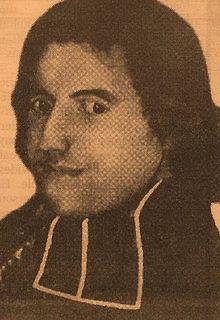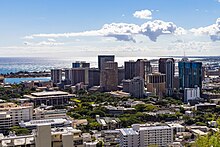Portal:Hawaii
The Hawaii Portal Hawaii (/həˈwaɪ.i/ hə-WY-ee; Hawaiian: Hawaiʻi [həˈvɐjʔi, həˈwɐjʔi]) is an island state of the United States, in the Pacific Ocean about 2,000 miles (3,200 km) southwest of the U.S. mainland. It is the only state not on the North American mainland, the only state that is an archipelago, and the only state in the tropics. Hawaii consists of 137 volcanic islands that comprise almost the entire Hawaiian archipelago (the exception, which is outside the state, is Midway Atoll). Spanning 1,500 miles (2,400 km), the state is physiographically and ethnologically part of the Polynesian subregion of Oceania. Hawaii's ocean coastline is consequently the fourth-longest in the U.S., at about 750 miles (1,210 km). The eight main islands, from northwest to southeast, are Niʻihau, Kauaʻi, Oʻahu, Molokaʻi, Lānaʻi, Kahoʻolawe, Maui, and Hawaiʻi, after which the state is named; the latter is often called the "Big Island" or "Hawaii Island" to avoid confusion with the state or archipelago. The uninhabited Northwestern Hawaiian Islands make up most of the Papahānaumokuākea Marine National Monument, the largest protected area in the U.S. and the fourth-largest in the world. Of the 50 U.S. states, Hawaii is the eighth-smallest in land area and the 11th-least populous; but with 1.4 million residents, it ranks 13th in population density. Two-thirds of Hawaii residents live on O'ahu, home to the state's capital and largest city, Honolulu. Hawaii is among the country's most demographically diverse states, owing to its central location in the Pacific and over two centuries of migration. As one of only seven majority-minority states, it has the only Asian American plurality, the largest Buddhist community, and largest proportion of multiracial people in the U.S. Consequently, Hawaii is a unique melting pot of North American and East Asian cultures, in addition to its indigenous Hawaiian heritage. Settled by Polynesians sometime between 1000 and 1200 CE, Hawaii was home to numerous independent chiefdoms. In 1778, British explorer James Cook was the first known non-Polynesian to arrive at the archipelago; early British influence is reflected in the state flag, which bears a Union Jack. An influx of European and American explorers, traders, and whalers soon arrived, leading to the decimation of the once-isolated indigenous community through the introduction of diseases such as syphilis, tuberculosis, smallpox, and measles; the native Hawaiian population declined from between 300,000 and one million to less than 40,000 by 1890. Hawaii became a unified, internationally recognized kingdom in 1810, remaining independent until American and European businessmen overthrew the monarchy in 1893; this led to annexation by the U.S. in 1898. As a strategically valuable U.S. territory, Hawaii was attacked by Japan on December 7, 1941, which brought it global and historical significance, and contributed to America's entry into World War II. Hawaii is the most recent state to join the union, on August 21, 1959. In 1993, the U.S. government formally apologized for its role in the overthrow of Hawaii's government, which had spurred the Hawaiian sovereignty movement and has led to ongoing efforts to obtain redress for the indigenous population. (Full article...) This is a Featured article, which represents some of the best content on English Wikipedia..
 Alexis Bachelot, SS.CC., (born Jean-Augustin Bachelot; 22 February 1796 – 5 December 1837) was a Catholic priest best known for his tenure as the first Prefect Apostolic of the Sandwich Islands. In that role, he led the first permanent Catholic mission to the Kingdom of Hawaii. Bachelot was raised in France, where he attended the Irish College in Paris, and was ordained a priest in 1820. He led the first Catholic mission to Hawaii, arriving in 1827. Although he had expected the approval of then Hawaiian King Kamehameha II, he learned upon arrival that Kamehameha II had died and a new government that was hostile towards Catholic missionaries had been installed. Bachelot, however, was able to convert a small group of Hawaiians and quietly minister to them for four years before being deported in 1831 on the orders of Kaʻahumanu, the Kuhina Nui (a position similar to queen regent) of Hawaii. Bachelot then traveled to California, where he served as an assistant minister while pastoring and teaching. In 1837, having learned of Queen Kaʻahumanu's death and King Kamehameha III's willingness to allow Catholic priests on the island, Bachelot returned to Hawaii, intending to continue his missionary work. However, by Bachelot's arrival, Kamehameha III had again changed his mind and Bachelot was removed from the island and confined to a ship for several months. He was freed only after the French and British navies imposed a naval blockade on the Honolulu harbor. Although he was later able to secure passage on a ship to Micronesia, he died en route and was buried on an islet near Pohnpei. His treatment in Hawaii prompted the government of France to dispatch a frigate to the island; the resulting intervention is known as the French Incident and led to the emancipation of Catholics in Hawaii. (Full article...) This is a Good article, an article that meets a core set of high editorial standards.
 William Pūnohuʻāweoweoʻulaokalani White (Hawaiian pronunciation: [puːnohuˌʔaːweoaːweoˌʔuləokəˈlɐni]; August 6, 1851 – November 2, 1925) was a Hawaiian lawyer, sheriff, politician, and newspaper editor. He became a political statesman and orator during the final years of the Kingdom of Hawaii and the beginnings of the Territory of Hawaii. Despite being a leading Native Hawaiian politician in this era, his legacy has been largely forgotten or portrayed in a negative light, mainly because of a reliance on English-language sources to write Hawaiian history. He was known by the nickname of "Pila Aila" or "Bila Aila" (translated as Oily Bill) for his oratory skills. Born in Lahaina, Maui, of mixed Native Hawaiian and English descent, White was descended from Kaiakea, a legendary orator for King Kamehameha I. Representing Lahaina in the legislative assemblies of 1890 and 1892, he became a political leader for the Liberal faction in the government and established himself as a leader in the opposition to the unpopular Bayonet Constitution of 1887. Throughout the terms of both legislatures, White led attempts to pass bills calling for a constitutional convention. He was criticized by the missionary Reform party for his support of the controversial lottery and opium bills. He and Joseph Nāwahī co-authored the proposed 1893 Constitution with Queen Liliʻuokalani. They were decorated Knight Commanders of the Royal Order of Kalākaua for their service and contribution to the monarchy. When an attempt by the queen to promulgate this constitution failed on January 14, 1893, White's opponents falsely alleged he had tried to incite the people to storm ʻIolani Palace and harm the queen and her ministers. White denied these charges and threatened to sue the newspapers. Three days after the attempted promulgation, the queen was deposed in a coup during the overthrow of the Kingdom of Hawaii on January 17, 1893. (Full article...) Selected Picture - 'Ōlelo (Language) -This section is here to highlight some of the most common words of the Hawaiian Language, ʻŌlelo, that are used in everyday conversation amongst locals.
ʻOno
Delicious, tasty, savory; to relish, crave; deliciousness, flavor, savor
State Facts
State Symbols:
Selected article -Honolulu (/ˌhɒnəˈluːluː/ HON-ə-LOO-loo; Hawaiian: [honoˈlulu]) is the capital and most populous city of the U.S. state of Hawaii, which is in the Pacific Ocean. It is the county seat of the consolidated City and County of Honolulu, situated along the southeast coast of the island of Oʻahu, and is the westernmost and southernmost major U.S. city. Honolulu is Hawaii's main gateway to the world. It is also a major hub for business, finance, hospitality, and military defense in both the state and Oceania. The city is characterized by a mix of various Asian, Western, and Pacific cultures, reflected in its diverse demography, cuisine, and traditions. Honolulu is Hawaiian for "sheltered harbor" or "calm port"; its old name, Kou, roughly encompasses the area from Nuʻuanu Avenue to Alakea Street and from Hotel Street to Queen Street, which is the heart of the present downtown district. The city's desirability as a port accounts for its historical growth and importance in the Hawaiian archipelago and the broader Pacific region. Honolulu has been the capital of the Hawaiian Islands since 1845, firstly of the independent Hawaiian Kingdom, and since 1898 of the U.S. territory and state of Hawaii. The city gained worldwide recognition following the Empire of Japan's attack on nearby Pearl Harbor on December 7, 1941, which prompted the entry of the U.S. into World War II; the harbor remains a major U.S. Navy base, hosting the United States Pacific Fleet, the world's largest naval command. (Full article...) Did you know? -
Hawaii News
Wikinews Hawaii portal
Quotes - "Ua mau ke ea o ka ʻāina i ka pono." — King Kamehameha III (Later became the Hawaiʻi State Motto.) On this day...There are no anniversaries listed for this day. Related portalsTopicsCategoriesAssociated WikimediaThe following Wikimedia Foundation sister projects provide more on this subject:
SourcesDiscover Wikipedia using portals |
























